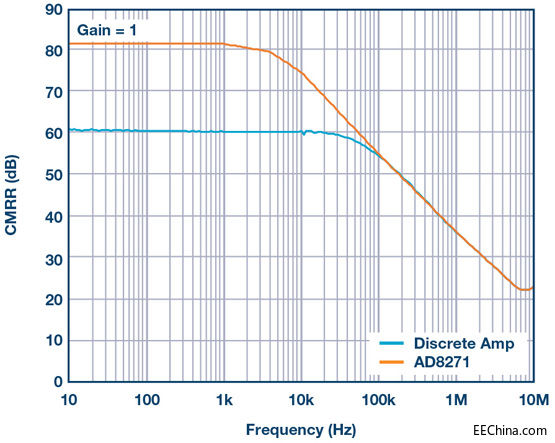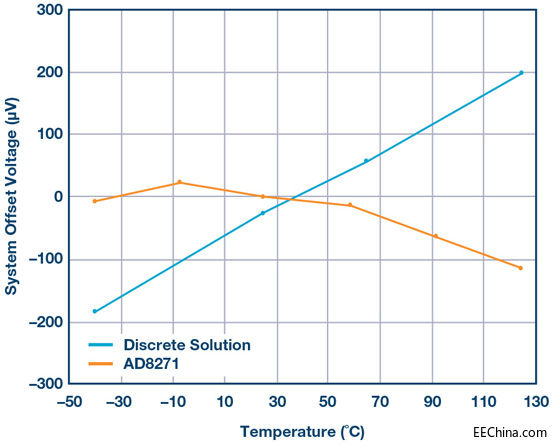|
The OP
Published on 2019-9-23 22:21
Only look at the author
This post is from Analogue and Mixed Signal
| ||
|
|
||
- 【Posts】Discrete Difference Amplifiers vs. Integrated Solutions
- 【Posts】Are you choosing the right power switch solution? Discrete MOSFET vs Integrated Load Switch
- 【Posts】Analog Circuit Analysis - Discrete and Integrated (English Edition)
- 【Posts】Buck Converters - From Discrete Circuits to Fully Integrated Modules
- 【Posts】The power amplifier circuit made of discrete devices looks like a mystery
- 【Posts】I would like to ask a question about the discrete device BUCK circuit
- 【Posts】Correctly analyze the role of each discrete component in the circuit - resistors, capacitors, inductors, diodes, transistors,
- 【Posts】How to build an undervoltage protection circuit using discrete components
- 【Download】Analog Circuit Design Discrete and Integrated (HD with Catalog)
- 【Download】Advantages of Integrated Power Modules over Discrete Regulators
- 【Download】Electronic circuit discreteness and integration
- 【Download】Performance comparison between integrated module power supply and discrete voltage regulator
- 【Download】Hardware Knight\'s Journey: Discrete Device ABC
- 【Download】MBUS bus discrete component simulation circuit
- 【Download】Latest Electronic Components Product Catalog Volume 1 - Discrete Semiconductor Devices 827 pages 12.2M
- 【Download】Latest Electronic Components Product Catalog Volume 1 - Discrete Semiconductor Devices 827 pages 12.2M.rar
- 【Design】Discrete component class D power amplifier modulation board
- 【Design】Flyback switching power supply 100~240Vac to 12V 2A, external MOS discrete solution, the chip uses OB2263 or its alternative model
- 【Design】Fully discrete 74LS138
- 【Design】Ultra-small ESP8266 module (discrete device with full functions)
- 【Design】【Digital Circuit】Basic logic gate discrete component circuit
- 【Design】74181 ALU NMOS Discrete Version
- 【Circuits】Internal cubic block diagram of switching power supply integrated circuit 5M0269R
- 【Circuits】Single-ended output difference amplifier circuit
- 【Circuits】400MHz differential amplifier (OPA660, BUF601)
- 【Circuits】Sensor Interface Circuit Using a Difference Amplifier
- 【Circuits】A differential amplifier with a common mode voltage up to ±1000V composed of INA110
- 【Circuits】A basic differential amplifier using only one OP amplifier
- 【Articles】Discrete devices are an excellent alternative to integrated MOSFET drivers
- 【Articles】Discrete devices – a superior alternative to integrated MOSFET drivers
- 【Articles】Buck Converters - From Discrete Circuits to Fully Integrated Modules
- 【Articles】Nexperia launches expanded discrete FET solutions family at APEC 2024
- 【Articles】Nexperia unveils expanded discrete FET solutions family at APEC 2024
- 【Articles】Driver Assistance Systems: New Radar Designs—Discrete or Integrated
-
Are you choosing the right power switch solution? Discrete MOSFET vs Integrated Load Switch
ApowerswitchgenerallyreferstoconnectinganddisconnectingpowertoaloadTherearemanyreasonswhyengineersusepowerswitchesintheirsystems.Duringsystemstartup,thepowersupplywouldbestressedifithadtopowerallsystemloadssimultaneouslyThepowerswitchcanals ...
-
Analog Circuit Analysis - Discrete and Integrated (English Edition)
Basedonthetheoryofsemiconductorphysics,thisbookfocusesontheexplanationofanalogcircuittechnologyandBiCMOStechnology,paysattentiontotheinterpretationofphysicalconcepts,andemphasizesthediscreteandintegrateddesignofanalogcircuitsBasedonthetheor ...
-
[Review of "Artificial Intelligence Practical Tutorial"] Python Function
#【《ArtificialIntelligencePracticeTutorial》Evaluation】PythonFunction##FunctionIfablockofcodeisneededmultipletimeswhendevelopingaprogram,butinordertoimprovetheefficiencyofwritingandthereuseofcode,thecodeblockswithindependentfunctionsareor ...
- Help! My newly bought power bank is broken!
- I have a question about the network port circuit?
- Useful Information | A technical expert shares 15 tips on power MOSFET [Collect it]
- I would like to ask you two newbie questions about serial communication
- Is it too late to switch to integrated circuits now?
- I want the model of two power chips. One is printed with 3YH 993 and the other is printed with 0B=R36.
- When attaching strain gauges, is it necessary to apply pressure before the glue is fully cured?
EEWorld Datasheet Technical Support
-
"Cross-chip" quantum entanglement helps build more powerful quantum computing capabilities
IBM scientists have achieved "cross-chip" quantum entanglement - successfully entangled two "Eagl
-
Ultrasound patch can continuously and noninvasively monitor blood pressure
A research team at the University of California, San Diego, has developed an innovative wearable
-
Europe's three largest chip giants re-examine their supply chains
At the Electronica 2024 CEO Roundtable held just last week, the CEOs of three chip giants, Infine
- It is reported that Kioxia will be approved for listing as early as tomorrow, and its market value is expected to reach 750 billion yen
- The US government finalizes a $1.5 billion CHIPS Act subsidy to GlobalFoundries to support the latter's expansion of production capacity in the US
- SK Hynix announces mass production of the world's highest 321-layer 1Tb TLC 4D NAND flash memory, plans to ship it in the first half of 2025
- UWB is a new way to use it in cars. Can wireless BMS also use it?
- Filling the domestic gap! China Mobile, Huawei and others jointly released the first GSE DPU chip
- Samsung Electronics NRD-K Semiconductor R&D Complex to import ASML High NA EUV lithography equipment
- Apple reveals the secret of its own chip success: competitors can't use the latest cutting-edge technology
- Problems with STM32 and passive buzzer playing sound
- Embedded Tutorial_DSP Technology_DSP Experiment Box Operation Tutorial: 2-28 Building a Lightweight WEB Server Experiment
- OPA847IDBVR op amp domestic replacement
- AG32VF407 Test UART
- [Digi-Key Follow Me Issue 2] Chapter 1: Sharing on receiving the goods
- What model is this infrared receiver? Which model can be used instead? Thank you
- Selling brand new unopened ZYNQ 7Z020 FPGA core board
- The LORA module used in the lithium battery-powered water meter setting can save energy when 100 water meters are installed in one corridor.
- I would like to ask, when a port is set to RX0, is it necessary to set the input and output direction of this port?
- Why is this year so difficult? It’s even more difficult than during the pandemic. I’m 30 and facing unemployment. I’m so confused.
- Ask about the voltage regulator test question
- [Xiaohua HC32F448 Review] About Xiaohua Semiconductor's UART interrupt sending and PRINTF construction and redirection
- 【BIGTREETECH PI development board】 HDMI output test
- 【BIGTREETECH PI development board】+08. Audio test (zmj)
- [Xiaohua HC32F448 Review] +RTC electronic clock
- 有奖直播报名| 高可靠性IGBT新选择 —— 安世半导体650V IGBT
- 【直播时间】12月19日(周四)下午15:00-16:30
【直播好礼】定制双肩商务包、30元京东卡、吸管玻璃杯
- 安世半导体直播报名中
- 直播主题:安世半导体理想二极管与负载开关,保障物联网应用的稳健高效运行
直播时间:12月17日(周二)下午14:00
报名就有机会获得:定制双肩商务包、30元京东卡、吸管玻璃杯
- PI 电源小课堂 | 无 DC-DC 变换实现多路高精度输出反激电源
- 时间:即日起-12月15日
看视频学习电源干货,答题赢取京东卡!
- 参会有好礼 | 2024 瑞萨电子MCU/MPU工业技术研讨会
- 深圳站:11月30日(周六)深圳湾万怡酒店
上海站:12月06日(周五)上海喜玛拉雅酒店
奖励设置:现金红包、螺丝刀套装或30元京东卡
- Littelfuse 新品赋能电子产品安全可靠并高效, 10+挑战等你探索!
- Littelfuse 应用赋能星球,覆盖了诸多应用痛点及解决办法,邀请工程师一起探索,解锁更多设计力!
- 下载资料赢好礼!看Vicor模块化电源解决方案如何推动创新
- 活动时间:即日起-2024年12月31日
如何参与:点击活动页内您想了解的模块,找到资料下载即可参与抽奖,活动结束后统一发奖!
- 有奖活动|英飞凌高密度双相电源模块为高性能运算平台而生
- 活动时间:即日起-12月15日
活动奖励:蓝牙音箱、氮化镓充电器套装、黑色小背包
- 本周精选下载推荐:电源管理基础Dummies
- 本周小编给大家带来一本超简单、超干货的电子书——《电源管理基础Dummies》!内容深入浅出,排版舒服简洁,分分钟能get到电源管理最核心的知识内容。
EEWorld
subscription
account

EEWorld
service
account

Automotive
development
circle

About Us Customer Service Contact Information Datasheet Sitemap LatestNews
- I want to get started quickly with halcon deep learning, what should I do?
- I want to get started with Xilinx deep learning, what should I do?
- I want to get started with microcontroller hardware development, what should I do?
- For the introduction to PCB design, please give a learning outline
- For beginners of PCB design software, please give a learning outline
- For the introduction of SMT placement machine programming, please give a learning outline
- What books should I read when I first learn fpga
- How to quickly get started with deep learning from scratch
- What do the four major mainstream CPU architectures mean?
- The origin of the name Bluetooth


 Room 1530, Zhongguancun MOOC Times Building,
Block B, 18 Zhongguancun Street, Haidian District,
Beijing 100190, China
Tel:(010)82350740
Postcode:100190
Room 1530, Zhongguancun MOOC Times Building,
Block B, 18 Zhongguancun Street, Haidian District,
Beijing 100190, China
Tel:(010)82350740
Postcode:100190
 京公网安备 11010802033920号
京公网安备 11010802033920号











 提升卡
提升卡 变色卡
变色卡 千斤顶
千斤顶